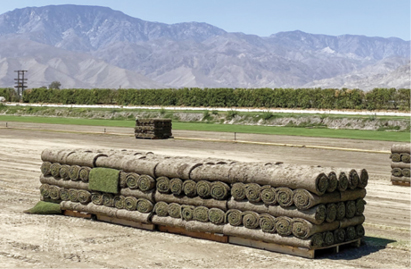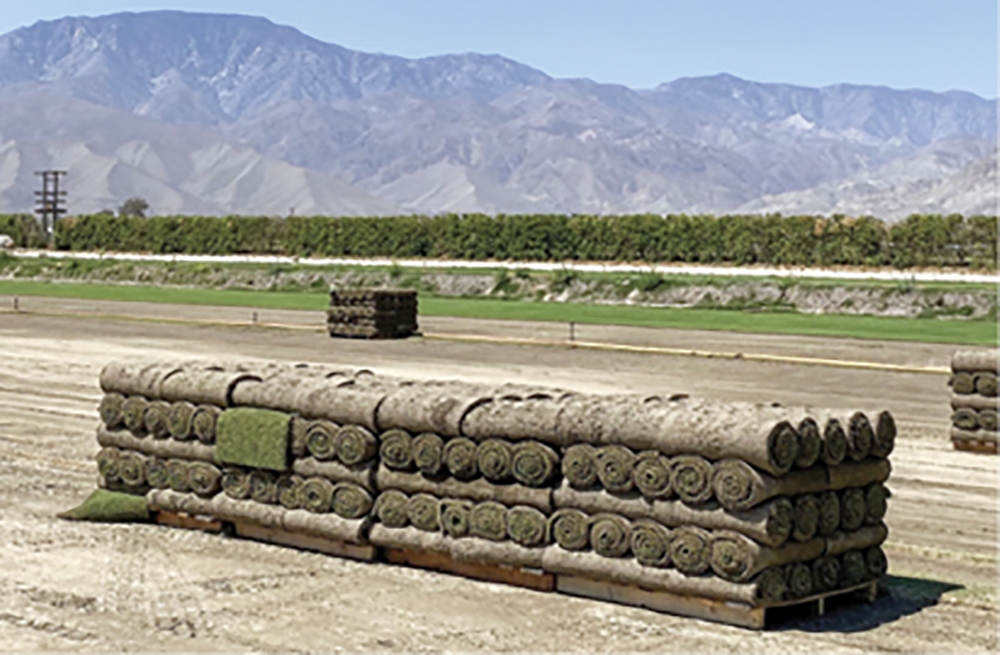Sod farms see demand shifts from pandemic and drought
Issue Date: May 12, 2021
By Kevin Hecteman
Source: California Farm Bureau Federation

Rolls of sod await shipment from a California farm. Sod growers say they have changed their operations to grow more warm-season grasses that typically require less water.
With California beginning to emerge from the COVID-19 pandemic but sliding deeper into drought, the people who operate sod farms have found two powerful forces buffeting their businesses.
John Marman of Palm Desert-based West Coast Turf describes doing business in COVID times as “interesting.” His business covers residential, commercial and municipal customers.
“We really shut down initially with the pandemic,” Marman said, noting that professional sports suffered one of the worst effects.
Football stadiums, for example, typically resod after hosting non-football events such as motocross races and concerts, Marman said—events sidelined by the COVID-19 pandemic.
“For us, that was heavily impacted,” he said. “That category of our business was close to nonexistent.”
On the residential side, “whether it be smaller landscape contractors or homeowners, or even big-box stores for that matter, (we) definitely saw an uptick,” Marman said. “Not enough to cover our losses in the sports-turf category, but I think people being forced at home wanted to appreciate their yards.”
Jimmy Fox, who runs American Sod Farms, said his Escondido operation was the hardest hit as pandemic shelter-in-place orders took hold in spring 2020.
“It didn’t shut us down all the way, but it definitely slowed business down, especially for the first three or four months,” Fox said, noting that this coincided with March through May—typically peak season for homeowner business.
Larry LeMay, president of A-G Sod Farms, saw the same mixed bag—more residential but less commercial demand. His company—which grows sod in Moreno Valley, Palmdale, Fresno and Stockton—works with a lot of schools and their sports fields.
“I think the schools were probably a little more hesitant, not knowing when they were going to be back,” LeMay said. “We had a downtick in that market.”
So far, Fox said, 2021 looks promising.
“Projections for this year are pretty strong,” he said. “I would say that most sod farms right now are probably seeing a slight challenge with inventory, because people were slowing down a little bit, being cautious, and now there’s a higher demand.”

California had 37 sod-growing operations covering 9,883 acres in 2019, resulting in $117.6 million in sales, according to the U.S. Department of Agriculture National Agricultural Statistics Service.
Those growers now must deal with California’s onrushing drought and the likelihood of water-use restrictions affecting, among other things, watering of lawns. That has prompted a move to low-water-use sod, something LeMay has been promoting.
“We’ve been really pushing hard for water-saving grasses, i.e., Bermudas, St. Augustine,” LeMay said. “They’ll get by with less water. They go dormant in the wintertime—no water requirements at all when they go dormant.”
Low-water sod is taking root especially on golf courses, Marman said.
“We’ve had a consistent gearing up for the drought over the last 15 years,” he said.
Marman named TifTuf, developed at the University of Georgia, as a sod capable of using 39% less water than Tifway 419, the world’s most popular Bermuda grass. Another new turf, Tahoma 31, was shown in Oklahoma State University testing to use even less water than TifTuf, Marman said.
“Through university testing that’s backed up by university documentation, you now have a grass that is encroaching on 50% water savings on top of the already existing Bermuda grasses,” he said. “You’re just moving in a direction where you now have grasses that perform better waterwise.”
Fox said when his company took over the Escondido sod farm in 2016, about 90% of its output was cool-season grasses tailored to temperate climes; the remainder was warm-season turf. The mix now is 60%/40% in favor of warm-season.
“Almost all our commercial projects are warm-season,” Fox said. “Anything going to parks, schools, golf courses is now some form of warm-season grass, Bermuda grass or Paspalum. The last drought had a heavy influence on what we’re shipping to market today.”
Going to warm-season grass can save 20% to 30% on a water bill if managed properly, he added.
“There’s still a lot of people that want that full-season look, but there has been a definite shift in two areas,” Fox said. “One, they are shifting away from cool-season to warm-season. We’re also seeing the size of yards shrink. People are putting in less grass, trying to save water.”
Marman said his company’s Northern California farms in Livingston and Patterson used to grow 80% cool-season grass and 20% warm-season about 20 years ago; now, those numbers have reversed.
“We’ve really flipped up there, and that is by and large because of water,” he said. “The same thing is starting to slowly happen down here in Southern California.”
Producers also said turf grass can mitigate the “heat island” effect, in which hardscapes reflect heat and warm the surrounding area as a result. A 5,000 square-foot lawn can be as much as 60 degrees cooler than hardscape, according to the Lawn Institute.
LeMay remembers the previous drought, and the resulting bullseye on people’s lawns.
“During the last drought, there was what I thought was an unfair target put on grass,” he said. “It’s just too easy for them to say, ‘Stop watering your yard.’ They don’t look at the other benefits.”
Fox echoed these concerns.
“Let’s use grass where its best use is, for play areas or runoff areas, for pets,” he said. “It’s a fact that grass is a lot cooler than any hard surface you can use, including synthetic turf. There’s plenty of studies to show that the heat-island effect is very real. You need to mitigate that, and the best way to do that is with trees and turf.”
(Kevin Hecteman is an assistant editor of Ag Alert. He can be contacted at khecteman@cfbf.com.)




